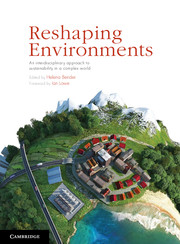Introduction - Reshaping environments – an opportunity for envisioning the future
Published online by Cambridge University Press: 05 February 2013
Summary
Humans reshape the environment by building, growing, digging up and moulding. But while we help create our environment, we are equally one of its creations. Humans and other living things have evolved genetically in response to environmental opportunities and restrictions. We have built physical structures and developed cultures and social institutions to respond to our biological needs and to enrich our experience of living as part of our environment. Climates influence architecture, weather alters moods, and views of buildings result in slower rates of recovery after surgery than a view of a tree (Sternberg 2009). The act of reshaping is an opportunity to envision the future, and to identify and understand the connections between humans and the world we inhabit and constantly shape. We see this text as a tool to engage with this opportunity.
While shaping and then reshaping of environments is often associated with degradation, damage and sometimes crises, it can also be associated with revegetation, rehabilitation and improvement. How we view an issue or situation can illuminate different pathways and choices. How we view our own role in effecting change can similarly result in different options emerging or pathways being created. In this book we acknowledge that there are multiple responses to situations, depending on resources and world views as well as the unique variables of each context. The important thing is to be conscious that each of us always has some choices to make. We choose our pathways through both action and inaction, as well as through the ethical stance that we take. The choices we each make are part of shaping the future. As we reshape our choices, behaviours and interactions, we reshape our future. Phillip Adams (1992), an Australian broadcaster, once said: ‘The paths to the future are made, not found.’ It is this sense of purpose that we celebrate in the development of this textbook. We hope it will inspire and guide you in forging your own paths to the future.
Information
- Type
- Chapter
- Information
- Reshaping EnvironmentsAn Interdisciplinary Approach to Sustainability in a Complex World, pp. 1 - 14Publisher: Cambridge University PressPrint publication year: 2012
References
Accessibility standard: Unknown
Why this information is here
This section outlines the accessibility features of this content - including support for screen readers, full keyboard navigation and high-contrast display options. This may not be relevant for you.Accessibility Information
- 2
- Cited by
